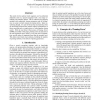Free Online Productivity Tools
i2Speak
i2Symbol
i2OCR
iTex2Img
iWeb2Print
iWeb2Shot
i2Type
iPdf2Split
iPdf2Merge
i2Bopomofo
i2Arabic
i2Style
i2Image
i2PDF
iLatex2Rtf
Sci2ools
INTERSPEECH
2010
2010
Direct observation of pruning errors (DOPE): a search analysis tool
The search for the optimal word sequence can be performed efficiently even in a speech recognizer with a very large vocabulary and complex models. This is achieved using pruning methods with empirically chosen parameters and the willingness to accept a certain amount of pruning errors. Quite unsatisfying though, it is state-of-the-art that such pruning errors are not directly detected but, instead, indirect consequences of them, providing only a rough picture of what happens during search. With the tool Direct Observation of Pruning Errors (DOPE), described in this paper, pruning errors are detected on the state hypothesis level, which is a very fine level of granulation, several orders of magnitude finer than the sentence level. This allows much more exact analyses, including the analysis of pruning methods, or the effects of pruning parameters.
| Added | 18 May 2011 |
| Updated | 18 May 2011 |
| Type | Journal |
| Year | 2010 |
| Where | INTERSPEECH |
| Authors | Volker Steinbiss, Martin Sundermeyer, Hermann Ney |
Comments (0)

